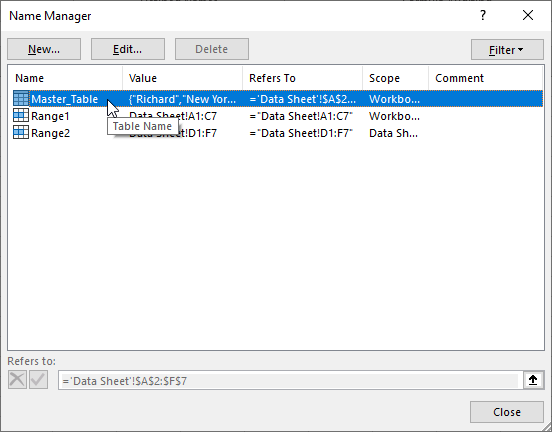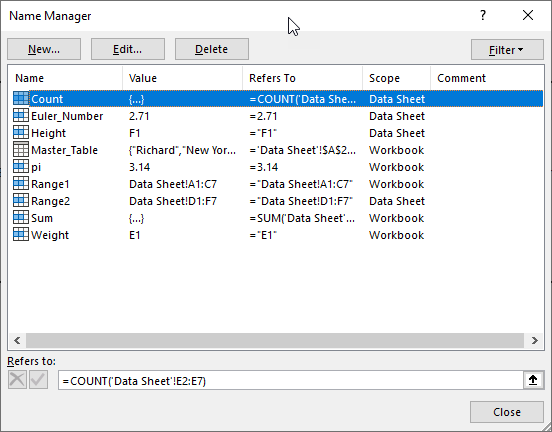Defined names refer to names given to constants, tables, cell ranges, or formulas so that you can refer to them in a formula without making it too complex to understand. The defined names are especially useful in complex calculations, such as calculating taxes for a whole financial year, where you will have difficulty finding and understanding the cells having different investments, taxable incomes, etc.
DsExcel supports defined names with the help of Names property in IWorkbook and IWorksheet interfaces and Name property in ITable interface.
Name a table by using Name property of ITable interface. The scope of the table name is workbook by default, as tables are created in workbook scope only. This name appears in Excel's Name Manager, as shown below.

Refer to the following example code to name the table.
| C# |
Copy Code |
|---|---|
// Name a table. ITable table = worksheet.Tables.Add(worksheet.Range["A1:F7"], true); table.Name = "Master Table"; | |
Name a cell range, formula, and constant using the Names property with Workbook and Worksheet objects. This property adds an IName object storing the name and referenced cell, formula, or constant. The name added to a workbook object is stored in the workbook scope, while the name added to a worksheet object is saved in the worksheet scope. It appears in Excel’s Name Manager, as shown below.

Refer to the following example code to name a cell range, a formula, and a constant in workbook scope.
| C# |
Copy Code |
|---|---|
// Name a range in wokrbook scope. workbook.Names.Add("Range1", "Data Sheet!A1:C7"); // Name formula in workbook scope. workbook.Names.Add("Sum", "=SUM(F2:F7)"); // Name a constant in workbook scope. workbook.Names.Add("pi", "3.14"); // Name a cell in workbook scope. workbook.Names.Add("Weight", "E1"); | |
Refer to the following example code to name a cell range, a formula, and a constant in worksheet scope.
| C# |
Copy Code |
|---|---|
// Name a range in worksheet scope. workbook.Worksheets[worksheet.Index].Names.Add("Range2", "Data Sheet!D1:F7"); // Name formula in worksheet scope. workbook.Worksheets[worksheet.Index].Names.Add("Count", "=COUNT(E2:E7)"); // Name a constant in worksheet scope. workbook.Worksheets[worksheet.Index].Names.Add("Euler_Number", "2.71"); // Name a cell in worksheet scope. workbook.Worksheets[worksheet.Index].Names.Add("Height", "F1"); | |